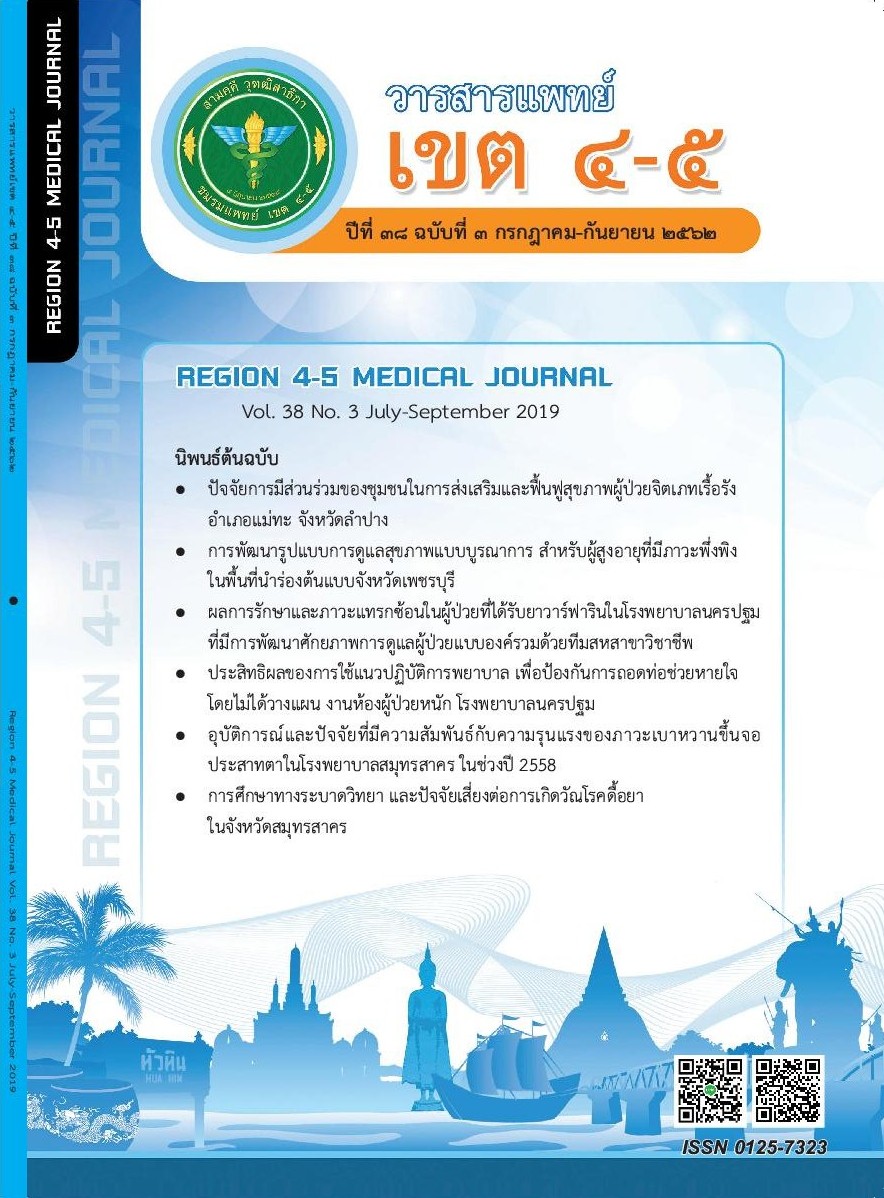Effectiveness of Implementing Clinical Nursing Practice Guideline for Preventing Unplanned Extubation in Intensive Care Unit at Nakhonpathom Hospital
Keywords:
clinical nursing practice guideline, unplanned extubationAbstract
Objective: Evaluation of implementing clinical nursing practice guideline (CNPG) for preventing unplanned extubation (UE) in intensive care unit at Nakhonpathom Hospital.
Materials & methods: This is a quasi experimental research. The purposive sampling was selected using 210 oral - intubated patients (male or female, aged ≥ 15 years old) who were admitted to adult intensive care units and intermediate care units at Nakhonpathom Hospital and were clustered into 2 groups: 1) The before - CNPG - implementing group, to which the previous work instruction applied, consisted of 70 patients selected from the medical records of the patients admitted in November and December 2018. 2) The after –CNPG- implementing groups, to which the developed CNPG applied, consisted equally in each month of 70 selected patients who were admitted in May and June 2019 (group 1 and group 2). The CNPG consists of 3 categories: 1) Nursing intervention includes the encouragement of communication, endotracheal tube stabilization, endotracheal suction, oral care, and safely physical restraints. 2) Close-up monitoring includes assessment of level of consciousness and motor behavior; pain, agitation, delirium assessment and management; and weaning readiness criteria assessment. 3) Utilizing consists of supervision, monitoring and evaluation. Data collection was done by using case-recorded forms and forms for evaluation of effectiveness of implementing CNPG for preventing UE. Descriptive statistics, chi-square test and F-test were used for data analysis.
Results: The result were 1) incidence rate of UE in the after- CNPG- implementing group 1, 2 were lower than the before - CNPG- implementing group, i.e. 17.81, 7.14, 24.90 per 1000 intubation days respectively. 2) Incidence numbers of UE in after- CNPG- implementing groups were significantly lower than before - CNPG- implementing group, (p=.024). 3) The numbers of intubation days used before and after the implementation of CNPG had no statistical significance (p=.178).
Suggestions: The study revealed that CNPG for preventing UE in oral-intubated patients had benefits and could apply to prevention of UE in the patients who uses nasotracheal tube, tracheostomy tube in addition to developing nursing documents model for facilitating the operations.
References
2. da Silva PS, Fonseca MC. Unplanned endotracheal extubations in the intensive care unit: systematic review, critical appraisal, and evidence-based recommendations. Anesth Analg 2012;114(5):1003-14.
3. Cosentino C, Fama M, Foà C, et al. Unplanned Extubations in Intensive Care Unit: evidences for risk factors. A literature review. Acta Biomed 2017;88(5S):55-65.
4. de Groot RI, Dekkers OM, Herold IH, et al. Risk factors and outcomes after unplanned extubations on the ICU: a case-control study. Crit Care 2011;15(1):R19.
5. Kiekkas P, Aretha D, Panteli E, et al. Unplanned extubation in critically ill adults: clinical review. Nurs Crit Care 2013;18(3):123-34.
6. McNett M, Kerber K. Unplanned Exubations in the ICU: Risk Factors and Strategies for Reducing Adverse Events. JCOM 2015;22(7):303-11.
7. Ismaeil MF, El-Shahat HM, El-Gammal MS, et al. Unplanned versus planned extubation in respiratory intensive care unit, predictors of outcome. Egypt J Chest Dis Tuberc 2014;63(1):219-31.
8. Kwon E, Choi K. Case-control Study on Risk Factors of Unplanned Extubation Based on Patient Safety Model in Critically Ill Patients with Mechanical Ventilation. Asian Nurs Res (Korean Soc Nurs Sci) 2017;11(1):74-8.
9. จงกล พลตรี, จิราพร ศิริโชค, รังสี ฆารไสว, และคณะ. การศึกษาอุบัติการณ์ถอดท่อช่วยหายใจโดยไม่ได้วางของผู้ป่วยที่เข้ารักษาในโรงพยาบาลศรีนครินทร์; การประชุมวิชาการ ครั้งที่ 27 ประจำปี 2554. Srinagarind Med J 2011:26 (Suppl):162.
10. สมจิตต์ แสงศรี. การพัฒนาและประเมินผลแนวปฏิบัติการพยาบาลเพื่อป้องกันการถอดท่อช่วยหายใจโดยไม่ได้วางแผนในหออภิบาลผู้ป่วยศัลยกรรม โรงพยาบาลสงขลานครินทร์ [วิทยานิพนธ์ปริญญาพยาบาลศาสตรมหาบัณฑิต]. สงขลา: มหาวิทยาลัยสงขลานครินทร์; 2555.
11. บังอร นาคฤทธิ์. การเลื่อนหลุดของท่อช่วยหายใจและระยะเวลาการใส่เครื่องช่วยหายใจในผู้ป่วยวิกฤตที่ได้รับการดูแลโดยใช้แนวปฏิบัติการพยาบาลที่สร้างจากหลักฐานเชิงประจักษ์. วารสารเกื้อการุณย์ 2558;22(1):129-43.
12. สมพร นรขุน. ผลของการใช้แนวปฏิบัติการพยาบาลต่ออัตราการเกิดการถอดท่อช่วยหายใจโดยไม่ได้วางแผนในผู้ป่วยใส่ท่อช่วยหายใจ. วารสารพยาบาลโรคหัวใจและทรวงอก 2559;27:72-84.
13. มณีนุข สุทธสนธิ์, ขนิษฐา แก้วกัลยา, วาสนา นัยพัฒน์. ผลของการใช้แนวปฏิบัติการพยาบาลต่ออัตราการเกิดท่อช่วยหายใจเลื่อนหลุดในผู้ป่วยอาการหนักที่ใส่ท่อช่วยหายใจ. วารสารการพยาบาลและการศึกษา 2560;10:58-70.
14. อุดมลักษณ์ เตียสวัสดิ์, ดลวิวัฒน์ แสนโสม, อัจฉราวรรณ นาเมืองจันทร์, และคณะ. การพัฒนาแนวปฏิบัติการพยาบาลผู้ป่วยใช้เครื่องช่วยหายใจในงานดูแลผู้ป่วยหนัก โรงพยาบาลขอนแก่น. วารสารการพยาบาลและการดูแลสุขภาพ 2560;35:194-206.
15. นภัสภรณ์ ดวงแก้ว. ประสิทธิผลของการใช้แนวปฏิบัติทางคลินิกสำหรับการป้องกันท่อช่วยหายใจ เลื่อนหลุดในหอผู้ป่วยหนักอายุรกรรมโรงพยาบาลลำปาง [วิทยานิพนธ์ปริญญาพยาบาลศาสตรมหาบัณฑิต]. เชียงใหม่: มหาวิทยาลัยเชียงใหม่; 2552.
16. ศูนย์คุณภาพ โรงพยาบาลนครปฐม. รายงานอุบัติการณ์ความเสี่ยงประจำปี 2558-2561. นครปฐม: โรงพยาบาลนครปฐม; 2561.
17. กลุ่มการพยาบาล โรงพยาบาลนครปฐม. วิธีปฏิบัติการพยาบาลเรื่องแนวทางปฏิบัติปฏิบัติการป้องกันท่อช่วยหายใจเลื่อนหลุดโดยไม่ได้วางแผน. นครปฐม: โรงพยาบาลนครปฐม; 2557.
18. National Health and Medical Research Council. A guide to the development, implementation and evaluation of clinical practice guidelines. Canberra: Commonwealth of Australia; 1999.
19. G*Power 3.1 manual [internet]. 2017 March 1 [cited 2019 June 8]. Available from: URL: http://www.gpower.hhu.de/fileadmin/redaktion/Fakultaeten/Mathematisch-Naturwissenschaftliche_Fakultaet/Psychologie/AAP/gpower/GPowerManual.pdf
20. Shapiro SE. Grading evidence for practice. Adv Emerg Nurs J 2010;32(1):59-67.
21. สถาบันวิจัยและประเมินเทคโนโลยีทางการแพทย์. การประเมินคุณภาพแนวทางปฏิบัติ สำหรับการวิจัยและการประเมินผล ฉบับภาษาไทย. นนทบุรี: กรมการแพทย์ กระทรวงสาธารณสุข; 2556.
22. Selvan k, Edriss H, Sigler M, et al. Self-extubation in ICU patients. The Southwest Respiratory and Critical Care Chronicles 2014;2(8):31-4.
23. Jarachovic M, Mason M, Kerber K, et al. The role of standardized protocols in unplanned extubations in a medical intensive care unit. Am J Crit Care 2011;20(4):304-11.
24. Chuang ML, Lee CY, Chen YF, et al. Revisiting Unplanned Endotracheal Extubation and Disease Severity in Intensive Care Units. PLoS One 2015;10(10):e0139864.
25. พิมพ์ใจ หัดประกอบ. ประสบการณ์ของผู้สูงอายุที่ใช้เครื่องช่วยหายใจในหออภิบาลผู้ป่วยหนักศัลยกรรม โรงพยาบาลตติยภูมิแห่งหนึ่ง [วิทยานิพนธ์ปริญญาพยาบาลศาสตรมหาบัณฑิต]. ขอนแก่น: มหาวิทยาลัยขอนแก่น; 2556.
26. วรางคณา สายสิทธิ์. เอกสารประกอบการสอน เรื่อง หลักการดูแลผู้ป่วยผู้ใหญ่ที่เจ็บป่วยวิกฤต. นครปฐม: คณะพยาบาลศาสตร์ มหาวิทยาลัยราชภัฎนครปฐม; 2562.
27. กวีศักดิ์ จิตตวัฒนรัตน์, บรรณาธิการ. เวชบำบัดวิกฤติศัลยศาสตร์ในเวชปฏิบัติ. เชียงใหม่: ภาควิชาศัลยศาสตร์ คณะแพทย์ศาสตร์ มหาวิทยาลัยเชียงใหม่; 2560.
28. สุนันทา ครองยุทธ. การจัดการภาวะสับสนเฉียบพลันของผู้ป่วยไอซียู. วารสารคณะพยาบาลศาสตร์มหาวิทยาลัยบูรพา 2016;23(4):89-9.
29. Kallet R, Summers TJ, Lipnick MS. Characteristics of Unplanned Extubation Events in the Critical Care Setting. RESP CARE 2018;63 (Suppl 10):3016944.
30. รุจิรางค์ วรรณธนาทัศน์, รัชตวรรณ ศรีตระกูล, สมปรารถนา ดาผา, และคณะ. การพัฒนารูปแบบการนิเทศทางคลินิกการพยาบาลในการบริหารยาความเสี่ยงสูง โดยการมีส่วนร่วมของพยาบาลผู้นิเทศทุกระดับ โรงพยาบาลนครปฐม. วารสารการพยาบาลและการดูแลสุขภาพ 2561:36(1);234-43.
Downloads
Published
How to Cite
Issue
Section
License
ลิขสิทธิ์บทความเป็นของผู้เขียนบทความ แต่หากผลงานของท่านได้รับการพิจารณาตีพิมพ์ลงวารสารแพทย์เขต 4-5 จะคงไว้ซึ่งสิทธิ์ในการตีพิมพ์ครั้งแรกด้วยเหตุที่บทความจะปรากฎในวารสารที่เข้าถึงได้ จึงอนุญาตให้นำบทความในวารสารไปใช้ประโยชน์ได้ในเชิงวิชาการโดยจำเป็นต้องมีการอ้างอิงถึงชื่อวารสารอย่างถูกต้อง แต่ไม่อนุญาตให้นำไปใช้ในเชิงพาณิชย์




